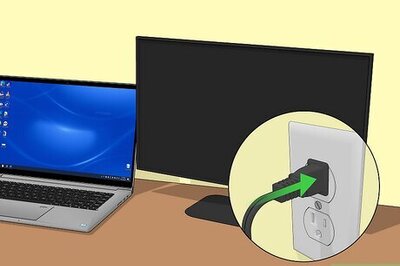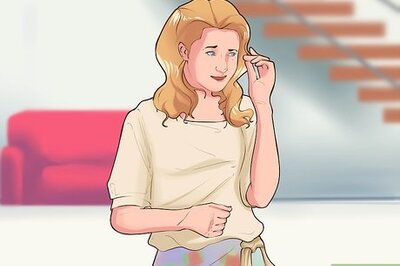
views
What is a cleft chin?
A cleft chin is a noticeable indentation in the center of the chin. Rather than a smooth “U” shape, a cleft chin (or “butt chin”) has a “W” like shape caused by a dimple or indentation that runs from the bottom of the jaw up toward the mouth. Some cleft chins are more prominent, while some are barely visible—it all depends on the tightness of the skin on the chin. Do you have a cleft chin? Take a look in the mirror. Is there a prominent dimple on your chin? If you smile, is there a dent in the center of your chin? If you touch the bottom of your chin, do you feel an indentation? If you answered “yes” to any of these questions, you likely have a cleft chin. Is having a cleft chin rare? Nope! Cleft chins are actually a common facial feature, even if they’re not very prominent. Do cleft chins ever go away? Cleft chins don’t go away naturally on their own, but surgery or fillers can help smooth out or reduce their appearance.
What causes a cleft chin?
A cleft chin forms as a baby develops in the womb. Each side of a person’s face develops on its own before they’re born. It isn’t until eight weeks after conception that a fetus’s face starts to look like a face, and that’s because the two sides finally merge. It’s during this merge that a cleft chin can form. If the chin connects with a slight gap, the baby is born with a cleft chin. Is a cleft chin a birth defect? No, a cleft chin isn’t a birth defect—it’s simply a facial feature! Is a cleft chin a medical issue? Nope, a cleft chin isn’t a medical issue and does not cause any health problems (it’s unrelated to cleft lips or cleft palates). However, some people consider it a cosmetic concern and may want to minimize its appearance.
Genetics can cause a cleft chin. Cleft chins are an inherited trait, meaning you get it from your parents and ancestors. Whether the cleft chin gene is dominant or recessive is up for debate, even though studies have debunked the possibility of cleft chin being a dominant trait, as not every child with cleft-chinned parents has a cleft chin. Scientists agree that the cleft chin facial feature is a hereditary trait, but how someone inherits it is still up for debate. All in all, everyone can agree on one thing: the shape of your chin is passed down from your parents.
Can you get rid of a cleft chin?
Getting rid of a cleft chin with surgery While surgery isn’t necessary for those with a cleft chin, it may help those who are insecure about the feature. A prominent cleft chin can be removed or reduced in size with a chin augmentation or mentoplasty. During the surgery, a plastic surgeon will place an implant in the chin to alter its shape and reduce the appearance of the dimple. Cost: Costs around $3,640 Recovery time: 4 to 6 weeks recovery time How long results last: May take 3 to 4 months to see the final result, but the results are permanent.As with any surgery, there are risks, including infection, scarring, swelling, and botched results. Always talk to your surgeon about potential risks and any concerns before having a procedure done.
Getting rid of a cleft chin with fillers For those looking to reduce or minimize the appearance of a cleft chin but are wary about a permanent surgery, cosmetic fillers may be best. Chin filler is a less invasive option that can help smooth out a cleft chin so it appears straighter. For this noninvasive procedure, a synthetic soft tissue filler is injected under the skin on the chin. The procedure takes only a few minutes and requires little to no recovery time. Cost: Costs around $600 per syringe Recovery time: 24-hour recovery time (primarily for swelling to fade) How long results last: Immediate but temporary results that last 6 months to 2 years. EXPERT TIP Kaveri Karhade, MD Kaveri Karhade, MD Board Certified Dermatologist Dr. Kaveri Karhade is a board certified Laser, Medical, and Cosmetic Dermatologist in the San Francisco Bay Area. Her areas of expertise are acne and hair loss. She has advanced training in injectables, lasers, surgery, and other cosmetic treatments, and has published extensive research in medical journals. She holds a BS from Michigan State University and a Doctor of Medicine (MD) from the University of Michigan Medical School. She completed her internship in Internal Medicine at New York University School of Medicine and her Residency in Dermatology at Brown University School of Medicine. Dr. Karhade is a fellow of the American Academy of Dermatology and a member of the American Society for Dermatologic Surgery. Kaveri Karhade, MD Kaveri Karhade, MD Board Certified Dermatologist Cleft chins can be smoothed non-surgically with a filler. Like any medical procedure, there are risks, so it should only be done by a board-certified dermatologist or plastic surgeon. The filler can last 1 to 2 years, so it’s something that needs to be done repeatedly, but not often.
What if you want a cleft chin?
Surgery can add a cleft chin if you like the way it looks. While there are surgeries to get rid of a cleft chin, there’s also a surgery that can add the appearance of a cleft chin for those who have a straight or smooth chin. For this surgery, a plastic surgeon removes soft tissue on the chin to form a dimple. In some cases, bone may need to be removed to create the desired effect. How much does surgery cost? Around $2,000. How quickly do you see results? Due to swelling, it may take 3 to 4 months to see desired results.
Is a cleft chin attractive?
Yes! Cleft chins can be very attractive. Whether you find cleft chins attractive or not is entirely up to you. After all, beauty is in the eye of the beholder! There are plenty of famously attractive men and women with cleft chins, including Henry Cavill, Demi Lovato, Matt Damon, Matt LeBlanc, Sandra Bullock, and Vanessa Hudgens. So, if you have a cleft chin, you’re in good company. Some believe that a cleft chin is a spiritual sign of confidence, charisma, and creativity. So, if you have a cleft chin, you may be a natural performer! If you don’t like your cleft chin or don’t find it attractive, that’s okay! Just remember, people are more than their physical features—you’re beautiful inside and out.

















Comments
0 comment